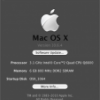Leopard on Series 7 NVIDIA nForce MCP + Intel CPU MOBOs
Installer Packages for nForce chipset MOBOs
143 members have voted
-
1. Would you be willing to donate an amount of your choosing to Mysticus C* to enable him to continue making and updating nForce chipset + Intel CPU MOBO-focussed Kernel/Drivers Installer packages, Combo Updater Packages......possibly even a DVD......?
-
Yes, before new and/or updated packages are released22
-
Yes, after new and/or updated packages are released18
-
Yes, but only after I have used the new and/or updated packages successfully on my system60
-
Unsure, I may donate after I have used the new and/or updated packages successfully on my system38
-
No5
-
-
2. Level of Demand for Installer Packages for nForce chipset MOBOs
-
Would you like it if new and/or updated installer packages for nForce chipset + Intel CPU MOBOs were to be developed by an OSx86 forum member?103
-
Would you be willing to donate an amount of your choosing to such a developer using an nForce chipset + Intel CPU nForce MOBO?68
-
Would you like it if new and/or updated installer packages for nForce chipset + AMD CPU MOBOs were to be developed by an OSx86 forum member?27
-
Would you be willing to donate an amount of your choosing to such a developer using an nForce chipset + AMD CPU nForce MOBO?20
-
Do you have a DESKTOP nForce chipset MOBO?109
-
Do you have a LAPTOP/NOTEBOOK nForce chipset MOBO?13
-
-
3. Nature of donations offered
-
Would you prefer to donate hardware (in good faith on the basis of trust) acceptable to the developer, to enable him/her to build a system on which to develop the installer packages?21
-
Would you prefer to donate cash (in good faith on the basis of trust) to the developer to defray his/her upfront cost of acquiring a system on which to develop the installer packages?122
-


Recommended Posts